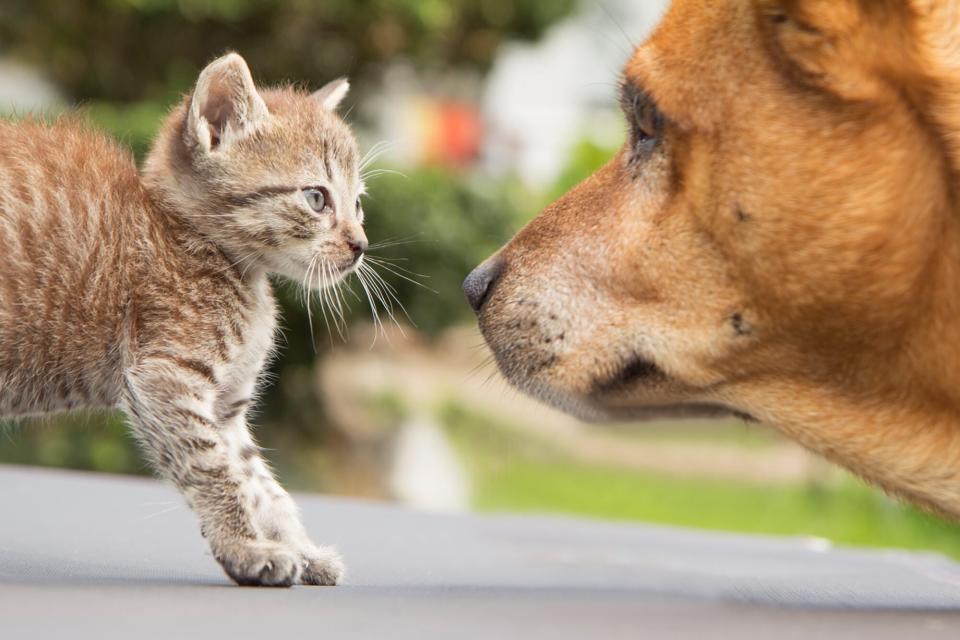How to Introduce a Dog to a Cat
Though they're often portrayed in cartoons as mortal enemies, dogs and cats generally get along and can quickly become the best of friends, especially if they are raised together. But if you have a pet that's struggling to get used to their new furry sibling, use these tips to smooth the waters before a new pet moves in.
6 Tips to Help You Introduce a Dog to a Cat
1. Choose a dog that has been cat tested.
If you are adopting a dog from a shelter, ask if he's been cat tested before you adopt. A dog that is already used to cats will be more likely to get along with your feline at home. Also, consider the breed or mix you select. Those with a higher prey drive, such as terriers and hounds, might struggle to keep calm around your cat. Keep in mind though, all dogs are individuals despite their breed, so there's no hard and fast rule about which dogs do best with cats. Older cats may have a more difficult time adjusting to a new dog in the house, so you may want to avoid unwanted stress on your cat and hold off on a new dog for the time being.
2. Create safe spaces.
Zazie Todd, Ph.D., social psychologist, founder of the popular blog Companion Animal Psychology, and author of Wag: The Science of Making Your Dog Happy, recommends creating safe places in your home for your cat to escape to.
"Make sure the environment allows the cat to go high up or under things such as behind a piece of furniture," she says. "Pull out a couple of dining chairs or move the couch away from the wall a bit." These small areas allow a frightened cat to make a quick getaway where the dog can't follow.
3. Keep your pets separate at first.
It's wise to keep your new dog in a separate room from your cat. This way, they will get used to the smells and sounds of each other without any chance of a bad encounter. It's also a good idea to put the dog in a crate whenever you let your cat run free. That way, the dog can see the cat but will be unable to give chase. Meanwhile, your cat can explore and check out the newcomer while he is safely tucked away in the crate.
4. Don't expect miracles.
Introducing dogs and cats is a lot like dating: you might get a match right away or it could take months. So don't rush things! Take your time and if your dog continues to show signs of barking, chasing, or growling after a few weeks, you probably need to enlist the help of a certified animal behavior consultant.

Fernando Trabanco Fotografía / Getty
RELATED: Why Training Your Dog Is So Important & How to Start
5. Control introductions between your dog and cat.
Before you let your dog and cat interact face-to-face, make sure your dog has been taught to give attention and offer a sit and down on cue. Put your dog on a leash, ask for a "sit" or "down" (giving them plenty of treats!) and let the cat wander about. If your dog and cat gently sniff each other (or ignore each other) it's a good sign things are working out. Treat and praise them both for good behavior.
However, if your dog starts to stare intently at your cat, barks, or whines anxiously, redirect his attention with a toy, treat, or a cue to sit or lay down followed by a treat. You want to make being around the cat a positive experience your dog looks forward to.
6. Take special care with kittens.
Because they are so playful, bouncy, and fearless, kittens will more quickly adapt to a new dog in the house. However, because they are so small and active they could easily be mistaken by your dog as something they should chase, or worse, grab. Never leave a kitten alone with any dog until you are completely sure they are safe together. In fact, never leave a cat of any age alone with a new dog unless you are there to supervise. When you are not home, find safe spaces for each of your pets to be separated from each other.

